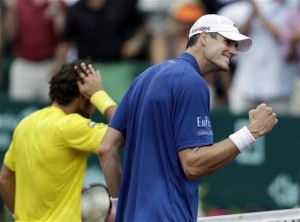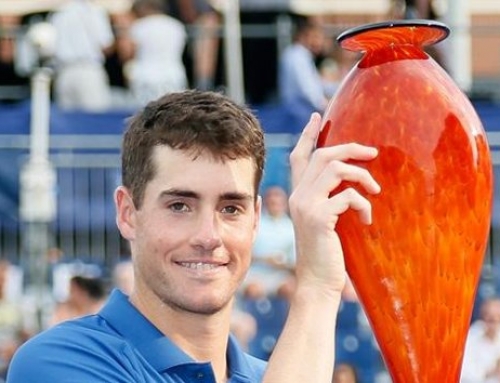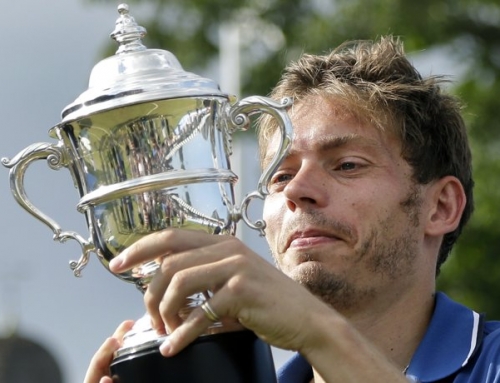 The myth used to be that big men prefer faster surfaces. Grass and hard courts were better for big guys who had big serves but lumbered around. Clay courts, by contrast, were bad for big men who allegedly lacked big groundstrokes. Indeed, as in basketball where big men were told to play center and close to the basket, once upon a time, big men in tennis were told to serve and volley, and you didn’t even have to be that big to be told to do this. In the old days, 6’5″ was huge for tennis and ultimately left you doomed to come to net.
The myth used to be that big men prefer faster surfaces. Grass and hard courts were better for big guys who had big serves but lumbered around. Clay courts, by contrast, were bad for big men who allegedly lacked big groundstrokes. Indeed, as in basketball where big men were told to play center and close to the basket, once upon a time, big men in tennis were told to serve and volley, and you didn’t even have to be that big to be told to do this. In the old days, 6’5″ was huge for tennis and ultimately left you doomed to come to net.
The first good big man to defy that convention was Todd Martin. He had a big serve, like most big men, but he moved well enough that he didn’t have to come to net every single time. At 6’6″, he was the first really success big man baseliner. Sure, he could come to net, and often did, but he wasn’t forced to play serve and volley. And like basketball where big men became more versatile and played further from the basket, so big men in tennis learned to play the baseline game.
Most big men in tennis struggle with speed of foot. There’s no big man that’s as fast as Nadal or even as fast as Federer who, at 31, is still plenty fast. The fastest somewhat big man is Andy Murray at 6’3″. Meanwhile, players like Berdych, del Potro, Cilic, and yes, even Anderson and Isner have to do something to hide their lack of blazing speed. Most of them play a kind of “big man” tennis. They thunder serves and rocket forehands. The pace is meant to be so overwhelming that less than stellar opponents get many fewer opportunities to control the point and big men are made to run far less.
Which gets us back to clay. Big men have found that clay, while not their best surface, have benefits, if they can play well. First, a high bouncing surface is good for their kick serves which goes even higher. Second, the slower surface gives them time to recover and stay in a point. Third, their hard hitting groundies often penetrate the slow surface giving the big player some advantage if they play smart and don’t overhit.
So it turns out two big men have reached the finals of clay.
In Casablanca, Kevin Anderson came from a set down to beat Martin Klizan, who had a sneaky good end of 2012 by winning a title, and beat him 26 64 62. Compared to the other guy his height (John Isner), Anderson is fleeter of foot. The two have similar backgrounds. Anderson played college tennis (he at Illinois, Isner at Georgia). Anderson is from South Africa but due to a combination of woes in South Africa and having married an American, Anderson stays in the US more than South Africa. Anderson has never had a great deal of success on the clay, so this is his best result by far. He’ll play the finals against veteran Tommy Robredo who upset Stan Wawrinka in 3 sets.
In Houston, John Isner was facing the player that ousted him in the finals, defending champ, Juan Monaco. Monaco was in a mentally better place last year when he won the title and eventually, for a brief moment, reached the top 10. However, this year, he’s struggled to win matches at all. The last few weeks have been some of his best all year long merely for the fact that he’s winning matches. To be fair, up until recently, Isner had also been struggling with his confidence, but he’s been feeling better at Houston. So in the battle of those seeking confidence boosters, Isner came up best, taking his match in three sets, 16 64 64. Monaco came out of the gates much quicker, but as Isner decided to play more aggressive in the latter two sets, he had better success as well.
Isner will face top see Nicolas Almagro in the finals. Almagro crushed Rhyne Williams, playing his first ATP semi, 62 61. Williams was no match for the better clay court player. Almagro has a huge serve, perhaps 3rd or 4th behind players like Isner and Querrey. For a guy his height, he serves huge. He also has one of the best backhands in the business. Williams, who has a pedigree of Tennessee tennis (his grandfather is the famous Tennessee coach, Mike de Palmer) had had his best week by reaching the semis.
Can the two big men win titles? Isner will have the tougher task trying to beat former top ten, Nico Almagro. He’s avoided playing tiebreaks so far, but may have to resort to them to win. Anderson may have the better draw. He has to hope that Robredo is playing up and down, though this is one of Robredo’s best effort in some time, a Spaniard who has seen his ranking much higher in the past, perhaps inspired by players like Haas who has repeatedly come back from injury.



![[Stockholm] Dimitrov wins first ATP title with 3-set victory over Ferrer](https://www.essentialtennis.com/wp-content/uploads/2013/10/20131021grigor-500x383.jpg)
![[Metz/St. Petersburg] Simon and Gulbis are champions!](https://www.essentialtennis.com/wp-content/uploads/2013/09/20130922gulbis-500x383.jpg)

